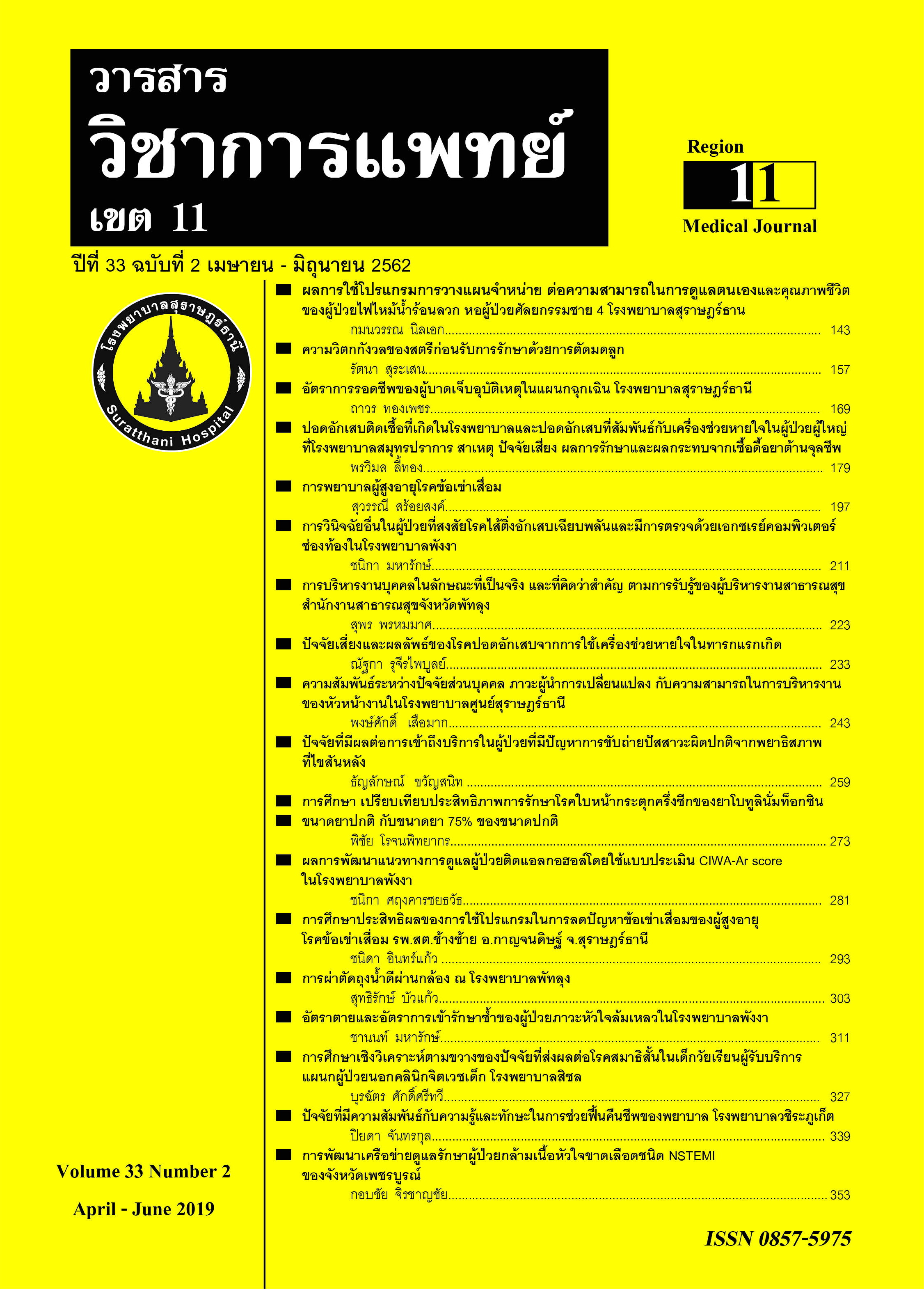Outcomes of patients admitted with Heart failure at Phang Nga Hospital
Keywords:
Heart failure, Mortality, Rehospitalization, LVEFAbstract
Introduction Heart failure is a significant syndrome that has a high burden. To date 3 subgroups have been divided by left ventricular ejection fraction according to 2016 The European Society of Cardiology (ESC) heart failure guideline (Heart failure with reduced, mid-range and preserved ejection fraction). These subgroups might have different outcomes. The aim of this study to define the mortality and heart failure rehospitalization rate of all heart failure patients and compare data of 3 heart failure subgroups at Phang Nga hospital.
Method This is a cross-sectional descriptive study. The Phang Nga hospital inpatient charts were review from October 2015 to September 2017 with principal diagnosis codes I11.0 and I50.* of International Classification of Disease (ICD-10). The primary outcomes are in-hospital mortality, 1-year mortality and 1-year heart failure rehospitalization rate. The secondary outcomes are the comparison of outcomes between 3 subgroups.
Results 289 patients were enrolled. Most of the patients were elderly with mean age 71.6 years and slightly more female (53.3%) with have the underlying disease of hypertension (80.3%) and dyslipidemia (67.1%). About 51.8% of the patients are in Heart failure with preserved ejection fraction subgroup. The in-hospital mortality, 1-year mortality, and rehospitalization rate due to heart failure were 4.2% 18.0% and 34.6 %, respectively. There is no significant difference between 3 subgroups.
Conclusion The outcomes show 18.0 % of one-year mortality rate and 34.6 % of one-year heart failure rehospitalization rate. Among three subgroups, There was no significant difference in mortality and rehospitalization rate.
References
2. Benjamin EJ, Virani SS, Callaway CW, Chamberlain AM, Chang AR, Cheng S, et al. Heart Disease and Stroke Statistics-2018 Update: A Report From the American Heart Association. Circulation. 2018;137(12):e67-e492.
3. Desai AS, Stevenson LW. Rehospitalization for heart failure: predict or prevent? Circulation. 2012;126(4):501-6.
4. Cook C, Cole G, Asaria P, Jabbour R, Francis DP. The annual global economic burden of heart failure. Int J Cardiol. 2014;171(3):368-76.
5. Savarese G, Lund LH. Global Public Health Burden of Heart Failure. Cardiac failure review. 2017;3(1):7-11.
6. Reyes EB, Ha JW, Firdaus I, Ghazi AM, Phrommintikul A, Sim D, et al. Heart failure across Asia: Same healthcare burden but differences in organization of care. Int J Cardiol. 2016;223:163-7.
7. Moleerergpoom W, Hengrussamee K, Piyayotai D, Jintapakorn W, Sukhum P, Kunjara-Na-Ayudhya R, et al. Predictors of in-hospital mortality in acute decompensated heart failure (Thai ADHERE). Journal of the Medical Association of Thailand = Chotmaihet thangphaet. 2013;96(2):157-64.
8. Ponikowski P, Voors AA, Anker SD, Bueno H, Cleland JGF, Coats AJS, et al. 2016 ESC Guidelines for the diagnosis and treatment of acute and chronic heart failure: The Task Force for the diagnosis and treatment of acute and chronic heart failure of the European Society of Cardiology (ESC)Developed with the special contribution of the
Heart Failure Association (HFA) of the ESC. Eur Heart J. 2016;37(27):2129-200.
9. Bhambhani V, Kizer JR, Lima JAC, vander Harst P, Bahrami H, Nayor M, et al. Predictors and outcomes of heart failure with mid-range ejection fraction.
Eur J Heart Fail. 2018;20(4):651-9.
10. Tsuji K, Sakata Y, Nochioka K, Miura M, Yamauchi T, Onose T, et al. Characterization of heart failure patients with mid-range left ventricular ejection fraction-a report from the CHART-2 Study. Eur J Heart Fail. 2017;19(10):1258-69.
11. Miro O, Javaloyes P, Gil V, Martin-Sanchez FJ, Jacob J, Herrero P, et al. Comparative Analysis of Short-Term Outcomes of Patients With Heart Failure With a Mid-Range Ejection Fraction After Acute Decompensation. Am J Cardiol. 2018.
12. Farre N, Lupon J, Roig E, Gonzalez-Costello J, Vila J, Perez S, et al. Clinical characteristics, one-year change in ejection fraction and long-term outcomes in patients with heart failure with mid-range ejection fraction: a multicentre prospective observational study in Catalonia (Spain). BMJ Open. 2017;7(12):e018719.
13. Chioncel O, Lainscak M, Seferovic PM, Anker SD, Crespo-Leiro MG, Harjola VP, et al. Epidemiology and one-year outcomes in patients with chronic heart failure and preserved, mid-range and reduced ejection fraction: an analysis of the ESC Heart Failure Long-Term Registry. Eur J Heart Fail. 2017;19(12):1574-85.
14. Cho JH, Choe WS, Cho HJ, Lee HY, Jang J, Lee SE, et al. Comparison of Characteristics and 3-Year Outcomes in Patients With Acute Heart Failure With Preserved, Mid-Range, and Reduced Ejection Fraction. Circ J. 2018.
15. Yaku H, Ozasa N, Morimoto T, Inuzuka Y, Tamaki Y, Yamamoto E, et al. Demo graphics, Management, and In-Hospital Outcome of Hospitalized Acute Heart Failure Syndrome Patients in Contemporary Real Clinical Practice in Japan- Observations From the Prospective, Multicenter Kyoto Congestive Heart Failure (KCHF) Registry. Circ J. 2018;82(11):2811-9.
16. Rajadurai J, Tse HF, Wang CH, Yang NI, Zhou J, Sim D. Understanding the Epidemiology of Heart Failure to Improve Management Practices: An Asia-Pacific Perspective. J Card Fail. 2017;23(4):327-39.
17. Yancy CW, Jessup M, Bozkurt B, Butler J, Casey DE, Jr., Drazner MH, et al. 2013 ACCF/AHA guideline for the management of heart failure: a report of the American College of Cardiology Foundation/American Heart Association Task Force on Practice Guidelines. J Am Coll Cardiol. 2013;62(16):e147-239.






